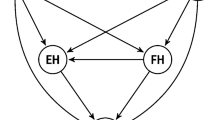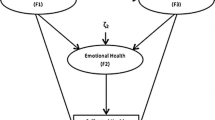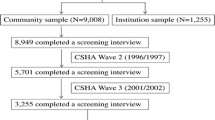Abstract
Aims
Self-rated health (SRH) is widely regarded a valid and reliable indicator of health status. The validity of self-rated health has been demonstrated in many studies, for example by predicting mortality over and above medical and epidemiological data. However, the meaning of SRH can differ between individuals, especially in elderly individuals with considerable individual differences in their physical health states. It is thus important to determine whether predictors of self-rated health vary according to physical health status in order to interpret self-rated health data.
Methods
In a representative survey study, 1174 individuals over 65 years of age rated their health and filled in questionnaires on subjective well-being, control beliefs, depressive symptoms, and functional health. Structural equation modeling with latent moderated structural equations was used to determine whether health status (number of illnesses) moderated the association of self-rated health with these predictors.
Results
Self-rated health was predicted by positive affect, depressive symptoms, control beliefs, and physical functioning. Moderated effects were found for positive affect and physical functioning, suggesting that there are stronger associations with positive affect in healthier individuals and stronger associations with physical functioning in less healthy individuals.
Conclusions
This implies that SRH has differential associations depending on health status, which should be taken into account in interpreting any research with SRH as predictor or criterion.

Similar content being viewed by others
Notes
Instruments (German and English versions), information on sampling and information on data access: www.german-ageing-survey.org
Age, sex, and region of residence were included as control variables because the study sample was disproportionally stratified according to these criteria.
References
Rutledge, T., Linke, S. E., Johnson, B. D., Bittner, V., Krantz, D. S., Whittaker, K. S., et al. (2010). Self-rated versus objective health indicators as predictors of major cardiovascular events: The NHLBI-sponsored Women’s Ischemia Syndrome Evaluation. Psychosomatic Medicine, 72(6), 549–555.
Idler, E. L., & Benyamini, Y. (1997). Self-rated health and mortality: A review of twenty-seven community studies. Journal of Health and Social Behavior, 38(1), 21–37.
McGee, D. L., Liao, Y., Cao, G., & Cooper, R. S. (1999). Self-reported health status and mortality in a multiethnic US cohort. American Journal of Epidemiology, 149(1), 41–46.
Benyamini, Y., Leventhal, E. A., & Leventhal, H. (2003). Elderly people’s ratings of the importance of health-related factors to their self-assessments of health. Social Science and Medicine, 56, 1661–1667.
Jylhä, M. (2009). What is self-rated health and why does it predict mortality? Towards a unified conceptual model. Social Science and Medicine, 69(3), 307–316.
Dowd, J. B., & Zajacova, A. (2007). Does the predictive power of self-rated health for subsequent mortality risk vary by socioeconomic status in the US? International Journal of Epidemiology, 36(6), 1214–1221.
Huisman, M., van Lenthe, F., & Mackenbach, J. (2007). The predictive ability of self-assessed health for mortality in different educational groups. International Journal of Epidemiology, 36(6), 1207–1213.
Berkman, L. F., Seeman, T. E., Albert, M., Blazer, D., Kahn, R., Mohs, R., et al. (1993). High, usual and impaired functioning in community-dwelling older men and women: Findings from the MacArthur Foundation Research Network on successful aging. Journal of Clinical Epidemiology, 46(10), 1129–1140.
Singh-Manoux, A., Ferrie, J. E., Lynch, J. W., & Marmot, M. (2005). The role of cognitive ability (Intelligence) in explaining the association between socioeconomic position and health: Evidence from the Whitehall II prospective cohort study. American Journal of Epidemiology, 161(9), 831–839.
Debra, A. H., Frank, M. A., Kristine, E. P., & Theresa, V. B. (2009). Among older adults, the responsiveness of self-rated health to changes in Charlson comorbidity was moderated by age and baseline comorbidity. Journal of Clinical Epidemiology, 62(2), 177–187.
Deeg, D. J. H., & Kriegsman, D. M. W. (2003). Concepts of self-rated health: Specifying the gender difference in mortality risk. The Gerontologist, 43(3), 376–386.
Schwartz, C. E., Bode, R., Repucci, N., Becker, J., Sprangers, M. A. G., & Fayers, P. M. (2006). The clinical significance of adaptation to changing health: A meta-analysis of response shift. Quality of Life Research: An International Journal of Quality of Life Aspects of Treatment, Care and Rehabilitation, 15(9), 1533–1550.
Mora, P. A., Di Bonaventura, M. D., Leventhal, E. A., & Leventhal, H. (2008). Psychological factors influencing self-assessments of health: Toward an understanding of the mechanisms underlying how people rate their own health. Annals of Behavioral Medicine, 36, 292–303.
Vandenberg, R. J., & Lance, C. E. (2000). A review and synthesis of the measurement invariance literature: Suggestions, practices, and recommendations for organizational research. Organizational Research Methods, 3(1), 4–69.
Idler, E. L., & Kasl, S. V. (1995). Self-ratings of health: Do they also predict change in functional ability? Journals of Gerontology. Series B: Psychological Sciences and Social Sciences, 50(6), S344–S353.
Singh-Manoux, A., Dugravot, A., Shipley, M. J., Ferrie, J. E., Martikainen, P., Goldberg, M., et al. (2007). The association between self-rated health and mortality in different socioeconomic groups in the GAZEL cohort study. International Journal of Epidemiology, 36(6), 1222–1228.
Liang, J. (1986). Self-reported physical health among aged adults. Journal of Gerontology, 41(2), 248–260.
Mackenbach, J. P., Simon, J. G., Looman, C. W. N., & Joung, I. M. A. (2002). Self-assessed health and mortality: Could psychosocial factors explain the association? International Journal of Epidemiology, 31(6), 1162–1168.
Benyamini, Y., Idler, E. L., Leventhal, H., & Leventhal, E. A. (2000). Positive affect and function as influences on self-assessments of health: Expanding our view beyond illness and disability. Journals of Gerontology. Series B: Psychological Sciences and Social Sciences, 55(2), P107–P116.
Benyamini, Y., Leventhal, E. A., & Leventhal, H. (1999). Self-assessments of health: What do people know that predicts their mortality? Research on Aging, 21(3), 477–500.
Mulsant, B. H., Ganguli, M., & Seaberg, E. C. (1997). The relationship between self-rated health and depressive symptoms in an epidemiological sample of community-dwelling older adults. Journal of the American Geriatrics Society, 45(8), 954–958.
Schneider, G., Driesch, G., Kruse, A., Wachter, M., Nehen, H.-G., & Heuft, G. (2004). What influences self-perception of health in the elderly? The role of objective health condition, subjective well-being and sense of coherence. Archives of Gerontology and Geriatrics, 39(3), 227–237.
Perrig-Chiello, P., Perrig, W. G., & Stähelin, H. B. (1999). Health control beliefs in old age–relationship with subjective and objective health, and health behaviour. Psychology Health and Medicine, 4(1), 83–94.
Adams, T., Bezner, J., & Steinhardt, M. (1997). The conceptualization and measurement of perceived wellness: Integrating balance across and within dimensions. American Journal of Health Promotion, 11(3), 208–218.
Kaplan, G., & Baron-Epel, O. (2003). What lies behind the subjective evaluation of health status? Social Science and Medicine, 56, 1669–1676.
Cott, C. A., Gignac, M. A. M., & Badley, E. M. (1999). Determinants of self rated health for Canadians with chronic disease and disability. Journal of Epidemiology and Community Health, 53(11), 731–736.
Whitbourne, S.K. (2001) Differential aging. In P. B. Baltes & N. J. Smelser (Eds.), International Encyclopedia of Social and Behavioral Sciences (pp. 3654–3658). Oxford: Pergamon.
Engstler, H. & Wurm, S. (2006) Datengrundlagen und Methodik [Data and methods]. In C. Tesch-Römer, H. Engstler, & S. Wurm (Eds.), Altwerden in Deutschland: Sozialer Wandel und individuelle Entwicklungen in der zweiten Lebenshälfte (pp. 47–83). Wiesbaden, Germany: VS Verlag.
Neller, K. (2005). Kooperation und verweigerung: Eine non-response-studie [Co-operation and refusal: A non-response study]. ZUMA-Nachrichten, 57, 9–36.
Charlson, M. E., Szatrowski, T. P., Peterson, J., & Gold, J. (1994). Validation of a combined comorbidity index. Journal of Clinical Epidemiology, 47(11), 1245–1251.
Wurm, S., Tomasik, M. J., & Tesch-Römer, C. (2010). On the importance of a positive view on aging for physical exercise among middle-aged and older adults: Cross-sectional and longitudinal findings. Psychology and Health, 25(1), 25–42.
Ware, J. E., & Sherbourne, C. D. (1992). The MOS 36-item short-form health survey (SF-36): I. Conceptual framework and item selection. Medical Care, 30, 473–483.
Hays, R. D., Sherbourne, C. D, & Mazel R. M. (1995). Users’ Manual for the Medical Outcomes Study (MOS) Core Measures of Health-Related Quality of Life. Santa Monica: RAND.
Watson, D., Clark, L. A., & Tellegen, A. (1988). Development and validation of brief measures of positive and negative affect: The PANAS scales. Journal of Personality and Social Psychology, 54(6), 1063–1070.
Radloff, L. S. (1977). The CES-D scale: A self-report depression scale for research in the general population. Applied Psychological Measurement, 1, 385–401.
Brandtstädter, J., & Renner, G. (1990). Tenacious goal pursuit and flexible goal adjustment: Explication and age-related analysis of assimilative and accommodative strategies of coping. Psychology and Aging, 5(1), 58–67.
Muthén, L. K., & Muthén, B. O. (Eds.). (2007). MPlus User’s Guide (5th ed.). Los Angeles, CA: Muthén and Muthén.
Klein, A., & Moosbrugger, H. (2000). Maximum likelihood estimation of latent interaction effects with the LMS method. Psychometrika, 65(4), 457–474.
Bandalos, D. L. (2002). The effects of item parceling on goodness-of-fit and parameter estimate bias in structural equation modeling. Structural Equation Modeling, 9(1), 78–102.
Aiken, L. S., & West, S. G. (1991). Multiple regression: Testing, interpreting interactions. Thousand Oaks, CA: Sage.
Beck, A. T. (1987). Cognitive models of depression. Journal of Cognitive Psychotherapy, 1(1), 5–37.
Greiner, P. A., Snowdon, D. A., & Greiner, L. H. (1996). The relationship of self-rated function and self-rated health to concurrent functional ability, functional decline, and mortality: Findings from the Nun Study. Journals of Gerontology. Series B: Psychological Sciences and Social Sciences, 51(5), S234–S241.
Idler, E. L., Hudson, S. V., & Leventhal, H. (1999). The meanings of self-ratings of health: A qualitative and quantitative approach. Research on Aging, 21(3), 458–476.
Little, T. D., Cunningham, W. A., Shahar, G., & Widaman, K. F. (2002). To parcel or not to parcel: Exploring the question, weighing the merits. Structural Equation Modeling, 9, 151–173.
Nasser, F., & Takahashi, T. (2003). The effect of using item parcels on ad hoc goodness-of-fit indices in confirmatory factor analysis: An example using Sarason’s reactions to tests. Applied Measurement in Education, 16, 75–97.
Schüz, B., Wurm, S., Warner, L. M., & Tesch-Römer, C. (2009). Health and subjective well-being in later adulthood: Different health states, different needs? Applied Psychology: Health and well-being, 1, 23–45.
Acknowledgments
This study was supported by the German Federal Ministry for Family Affairs, Senior Citizens, Women and Youth [Grant 301-1720-2/2] and the German Ministry of Education and Research [Grant 01ET0702]. I.S. was supported by the International Max Planck Research School “The Life Course: Evolutionary and Ontogenetic Dynamics” (LIFE). We would like to thank Christopher Marx for assistance during the preparation of the manuscript.
Author information
Authors and Affiliations
Corresponding author
Rights and permissions
About this article
Cite this article
Schüz, B., Wurm, S., Schöllgen, I. et al. What do people include when they self-rate their health? Differential associations according to health status in community-dwelling older adults. Qual Life Res 20, 1573–1580 (2011). https://doi.org/10.1007/s11136-011-9909-4
Accepted:
Published:
Issue Date:
DOI: https://doi.org/10.1007/s11136-011-9909-4




